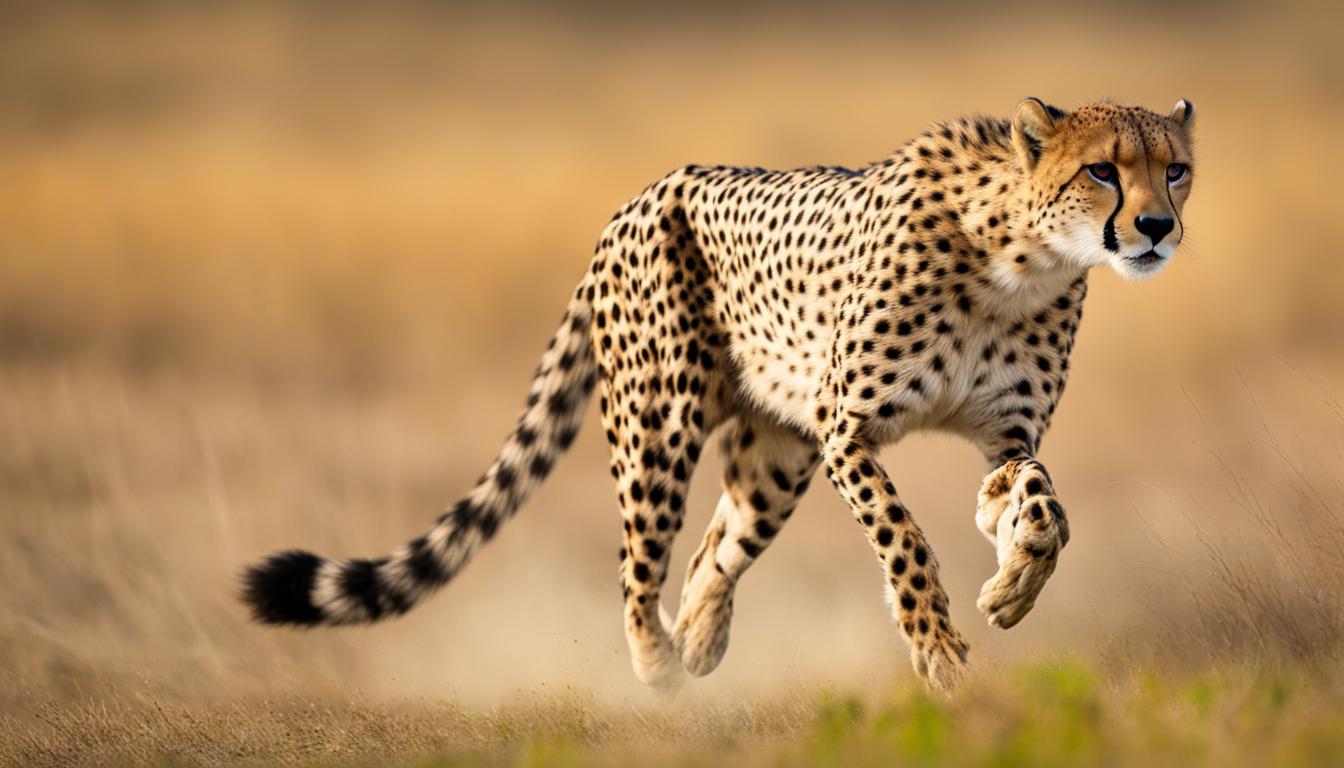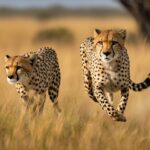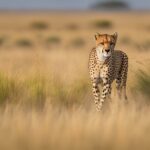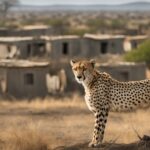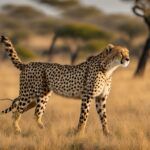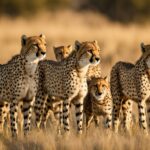Cheetahs are known as the world’s fastest land animals, reaching speeds of up to 120kph or 75mph. They are incredibly agile hunters, capable of incredible acceleration. Cheetahs can increase their speed by 10kph in a single stride, thanks to their unique adaptations. Adult cheetahs weigh around 41-45kg for males and 36-37kg for females.
When it comes to speed, cheetahs are in a league of their own. They hold the title for being the fastest land animals, capable of reaching incredible velocities. But what allows these magnificent creatures to run at such extraordinary speeds?
How do cheetahs run so fast?
Cheetahs are renowned for their extraordinary running abilities, reaching speeds of up to 120kph or 75mph. Their remarkable speed is made possible by a combination of unique adaptations that enable them to sprint with incredible acceleration.
One of the key factors that contribute to a cheetah’s speed is its long tail. Acting as a counterbalance, the cheetah’s tail helps with high-speed maneuvering, allowing the predator to swiftly change direction while maintaining stability. This tail serves as a vital tool during quick turns, allowing the cheetah to maintain balance and continue its chase.
The cheetah’s body structure also plays a crucial role in its impressive running capabilities. With a flexible spine, cheetahs can stretch their bodies to their full potential, elongating their strides and covering more ground with each step. This flexibility and elongation of the spine enable them to achieve greater speed and efficiency during their sprints.
“Cheetahs have evolved a combination of physical attributes that allow them to run at incredible speeds. Their long tail, flexible spine, and efficient respiratory system all work together to give them an edge in the hunt,” says Dr. Jane Donovan, a wildlife biologist.
The Respiratory System: Oxygen for Speed
In addition to their physical adaptations, cheetahs possess a highly efficient respiratory system that helps fuel their bursts of speed. Cheetahs have larger lungs compared to other big cats, allowing for a higher intake of oxygen. This increased oxygen supply is then swiftly delivered to their powerful muscles, providing the necessary energy for sprinting at astonishing speeds.
The structure of a cheetah’s paws and claws also aids in its exceptional running ability. Their paws are specially designed for traction, acting like running spikes as they dig into the ground and provide grip during high-speed pursuits. The claws, though non-retractable like those of other big cats, act as cleats, further enhancing their stability and speed.
With their long legs and stretched leg bones, cheetahs possess an ideal body structure for running at high speeds. The combination of these adaptations allows cheetahs to sprint with unparalleled agility and grace, making them the true champions of the animal kingdom when it comes to speed.
| Adaptation | Function |
|---|---|
| Long Tail | Aids in high-speed maneuvering and balance |
| Flexible Spine | Allows for quick movements and longer strides |
| Efficient Respiratory System | Delivers oxygen quickly to muscles for increased speed |
| Paws and Claws | Provide grip and stability during sprints |
| Long Legs and Stretched Leg Bones | Enhance stability and efficiency at high speeds |
Where do cheetahs live?
Cheetahs are primarily found in the dry savannah and grasslands of Africa. They have a wide distribution across the continent, with populations in countries such as Kenya, Tanzania, Botswana, Namibia, and South Africa. However, their habitat is facing significant challenges, leading to a decline in their population.
A major threat to cheetahs is habitat loss and fragmentation. Human activities such as agriculture, urbanization, and the expansion of infrastructure have resulted in the destruction of their natural habitat. As a result, cheetahs are losing access to their traditional hunting grounds and are forced to compete with other predators for resources.
Over the last century, the global cheetah population has decreased by 90%. Currently, there are approximately 6,700 cheetahs left in the wild, and they are classified as a vulnerable species. One-third of the remaining cheetahs live in southern Africa, particularly in Namibia. Additionally, there are about 50 Asiatic cheetahs left in Iran, making it the only country where this subspecies still exists.
Efforts are being made to conserve and protect cheetah habitats. National parks, reserves, and conservation organizations are working together to create safe spaces for cheetahs and implement measures to minimize human-wildlife conflict. It is crucial to raise awareness about cheetah conservation and support initiatives that aim to preserve these magnificent creatures for future generations.
Cheetah Habitat Statistics:
| Country | Approximate Cheetah Population |
|---|---|
| Kenya | 1,000 |
| Tanzania | 800 |
| Botswana | 550 |
| Namibia | 2,000 |
| South Africa | 1,500 |
| Iran | 50 |
Image source: https://seo-writing.ai/32_6.png
What do cheetahs eat?
Cheetahs are carnivorous hunters with a specialized diet. They primarily prey on a variety of animals, ranging from small to medium-sized. Cheetahs have adapted their hunting strategy to take advantage of their incredible speed and agility.
Hunting Strategy
When hunting, cheetahs rely on their speed and agility to get close to their prey. They use their keen eyesight to spot potential targets from a distance. Once they have identified a suitable prey, cheetahs will carefully stalk their target, using the surrounding terrain for cover.
“The cheetah approaches its prey silently, minimizing the chances of detection. It relies on its incredible speed to chase down its prey in short, explosive bursts.”
When the moment is right, cheetahs will initiate their sprint, reaching speeds of up to 120kph (75mph) in just a few seconds. They employ remarkable acceleration, allowing them to cover short distances quickly. Cheetahs rely on their incredible speed to close the gap between themselves and their prey, enabling them to launch a successful attack.
Cheetah Diet
Cheetahs feed on a wide range of animals, depending on what is available in their habitat. Their diet includes small to medium-sized ungulates such as gazelles, impalas, pukus, and warthogs. They also target smaller prey like rabbits and game birds when larger options are scarce.
Unlike other big cats, cheetahs are not built for prolonged fights or wrestling down large prey. Instead, their hunting strategy relies on quick, efficient kills. Once a cheetah has caught its prey, it will suffocate the animal by crushing its windpipe, ensuring a swift and humane death.
It is important to note that cheetahs are not solitary hunters. They are known to cooperate with siblings or form small hunting groups, particularly when targeting larger ungulates. By hunting in groups, cheetahs can increase their chances of a successful kill and secure a meal for all members involved.
Overall, the cheetah’s diet consists of a variety of prey, which it hunts down with its incredible speed and agility. This carnivorous hunter plays a crucial role in maintaining the balance of ecosystems in which it resides.
What is the Difference Between a Leopard and a Cheetah?
Leopards and cheetahs may belong to the same family, but they have distinct differences that set them apart. Understanding these differences can help you identify these majestic big cats. Let’s explore the characteristics that make each species unique.
Appearance
When it comes to their appearance, one of the most noticeable differences between leopards and cheetahs is their coat patterns. Cheetahs have solid round spots, while leopards have rosettes, which are larger, more irregular-shaped spots with a dark border. Additionally, cheetahs have a leaner and more streamlined body shape, whereas leopards are stockier and more muscular.
Habitat and Range
Leopards have a broader geographic range compared to cheetahs. Leopards can be found in various habitats across Africa, Central Asia, India, and even parts of China. On the other hand, cheetahs are primarily found in Africa and Iran, with a specific preference for open grasslands and savannahs.
Behavior and Hunting
Leopards and cheetahs also differ in their hunting strategies and behavior. Leopards are known for their stealth and strength. They are capable climbers and often drag their prey into trees for safekeeping. Cheetahs, on the other hand, rely on their incredible speed and agility to chase down and catch their prey. Unlike leopards, cheetahs do not have the ability to retract their claws fully.
| Cheetah | Leopard | |
|---|---|---|
| Appearance | Solid round spots | Irregular rosettes |
| Habitat | Africa and Iran | Africa, Central Asia, India, China |
| Hunting Strategy | Speed and agility | Stealth and climbing ability |
Both leopards and cheetahs are incredible creatures, each with their own unique characteristics and adaptations. Understanding the differences between them allows us to appreciate the diversity of the animal kingdom and the wonders of nature.

Fun Fact:
Did you know that cheetah cubs have a unique mantle of hair on their backs called a “mantle stripe”? This stripe acts as camouflage, making the cubs blend in with tall grass and protecting them from predators.
Table: A Comparison of Cheetah Cubs and Adult Cheetahs
| Cheetah Cub | Adult Cheetah | |
|---|---|---|
| Size | Small and vulnerable | Larger and more robust |
| Coat | Thick fur with small, round spots | Shorter fur with large, elongated spots |
| Dependence | Relies on mother for protection and nourishment | Independent and hunts for itself |
| Survival Skills | Develops hunting and survival skills from mother | Highly skilled hunter with exceptional speed |
Observing the development and growth of cheetah cubs is a fascinating experience. These small and playful creatures eventually transform into the magnificent and majestic cheetahs we all know and admire.
Conclusion
Cheetahs are truly remarkable creatures, known for their incredible speed and agility. With their adaptations, cheetahs can reach speeds of up to 120kph or 75mph, making them the fastest land animals. They are specialized hunters, relying on their speed and agility to catch prey.
However, cheetah populations are facing threats such as habitat loss and fragmentation, leading to a decrease in their numbers. It is crucial to protect and conserve these majestic animals for future generations. The global cheetah population has already decreased by 90% over the last century, highlighting the urgent need for conservation efforts.
By preserving their natural habitats and implementing conservation measures, we can help ensure the survival of cheetahs in the wild. Through education and awareness, we can also promote the understanding of the importance of cheetahs in maintaining a balanced ecosystem. Together, we can make a difference in protecting and honoring the world’s fastest land animal, the cheetah.
What enables cheetahs to conserve energy during their sprints?
Cheetah sprint distance and energy conservation are facilitated by their flexible spine, large nasal passages, and powerful leg muscles. These adaptations allow cheetahs to take long strides, breathe efficiently, and generate explosive speed, reducing the energy exerted during sprints.
FAQ
How fast can cheetahs run, and what enables their incredible speed?
Cheetahs can reach speeds of up to 120kph or 75mph, making them the world’s fastest land animals. Their long tail, flexible spine, big lungs, feet and claws, and long legs and stretched leg bones all contribute to their incredible speed.
How do cheetahs run so fast?
Cheetahs run so fast due to their unique adaptations. Their long tail acts as a counterbalance, aiding in high-speed maneuvering. The flexible spine allows for quick movements and longer strides. Cheetahs have big lungs that deliver oxygen quickly to their muscles, allowing for increased speed. Finally, their feet and claws provide grip, similar to running spikes, and their long legs and stretched leg bones provide stability at high speeds.
Where do cheetahs live?
Cheetahs are primarily found in the dry savannah and grasslands of Africa. However, their habitat is facing loss and fragmentation, posing a threat to their survival. Over the last century, the global cheetah population has decreased by 90%. One-third of cheetahs live in southern Africa, and there are about 50 Asiatic cheetahs in Iran, the only country where this subspecies still exists. Currently, there are approximately 6,700 cheetahs left in the wild, and they are classified as a vulnerable species.
What do cheetahs eat?
Cheetahs are carnivorous hunters that prey on a variety of animals. They will hunt small prey like rabbits and game birds, as well as larger prey like gazelles, impalas, pukus, and warthogs. Cheetahs can use their incredible speed to chase down and catch their prey, utilizing their hunting strategy of speed and agility. They can also hunt in groups to take down larger ungulates.
What is the difference between a leopard and a cheetah?
Cheetahs belong to the family Acinonyx, while leopards belong to the family Panthera. Cheetahs are found in Africa and Iran, whereas leopards have a wider distribution in Africa, Central Asia, India, and China. Visually, cheetahs have solid round spots, while leopards have rosettes. Leopards are bulkier and lack the black “tear stains” that run from the corner of the eye down the muzzle, which cheetahs have.
What is a baby cheetah called?
Baby cheetahs are called cubs. Female cheetahs give birth to between two and eight cubs, which they leave when they are 16-24 months old. The life expectancy of a cheetah is about 7 years.
Conclusion
Cheetahs are truly remarkable creatures, known for their incredible speed and agility. With their adaptations, cheetahs can reach speeds of up to 120kph or 75mph, making them the fastest land animals. They are specialized hunters, relying on their speed and agility to catch prey. However, cheetah populations are facing threats such as habitat loss and fragmentation, leading to a decrease in their numbers. It is crucial to protect and conserve these majestic animals for future generations.

